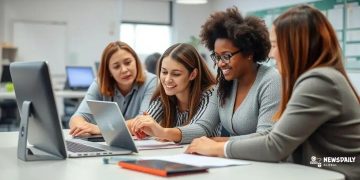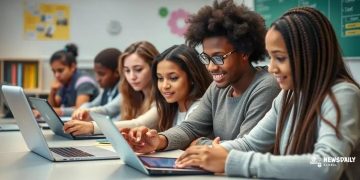Neuroeducation: How brain science is transforming learning

Neuroeducation combines neuroscience and educational practices to enhance learning by applying brain science insights, fostering personalized learning, and addressing social-emotional skills.
Neuroeducation: How brain science is shaping learning methods. Have you ever wondered how our understanding of the brain can transform education? Let’s dive into how these insights can enhance the learning experience.
Understanding neuroeducation and its principles
Understanding neuroeducation is crucial for grasping how brain science can improve learning methods. By merging insights from neuroscience with educational practices, we can create more effective ways for students to learn.
This approach is built on a few foundational principles that emphasize how the brain processes information, learns new skills, and retains knowledge. Incorporating these techniques in classrooms can lead to significant improvements in student engagement and success.
Key Principles of Neuroeducation
When exploring neuroeducation, it’s important to recognize several core principles:
- Brain plasticity: The brain is capable of changing and adapting throughout a person’s life.
- Active learning: Students retain more information when they actively participate in their learning.
- Emotional connection: Learning is enhanced when students feel emotionally engaged with the material.
By understanding these principles, educators can tailor their methods to align better with how the brain naturally functions. Research in this field shows that when teachers apply neuroeducational principles, it creates an environment where students can thrive. This is not just about memorizing facts but also about fostering a love for learning. As we continue to explore the intersection of brain science and education, we can find innovative strategies that promote deeper understanding and lasting knowledge.
Giving students the tools to learn effectively means embracing trial and error. Neuroeducation encourages a growth mindset, where mistakes are viewed as opportunities for learning rather than failures. This perspective is essential to building resilience and curiosity, which will serve students well beyond the classroom.
The role of brain science in learning
The role of brain science in learning is increasingly recognized as essential in creating effective educational practices. By exploring how our brains function, educators can adapt teaching methods to align with natural learning processes.
Research shows that understanding brain functions can lead to improved strategies that enhance student performance. When students engage with materials that reflect how their brains work, they retain information better and develop a love for learning.
Key Contributions of Brain Science
Brain science offers several insights that are helpful for educators:
- Memory formation: Short-term memory processes information but needs repetition to move to long-term memory.
- Attention span: Understanding that students have varying attention spans helps educators design lessons that capture and hold interest.
- Cognitive load: Keeping lessons within the brain’s limits can prevent overwhelm and enhance learning.
By integrating these findings, educators can create a more supportive learning environment. This involves recognizing the diverse learning styles and paces of students. Individual differences in brain development imply that a one-size-fits-all approach does not work effectively.
Students benefit from active learning experiences that stimulate both the logical and creative parts of the brain. Activities like group discussions, hands-on projects, and technology integration promote deeper understanding. These strategies align with how the brain learns best and can motivate students to stay engaged in their education.
Effective practices in neuroeducation

Effective practices in neuroeducation are essential for creating environments where students thrive. Teachers who apply these practices can significantly enhance learning experiences by aligning methods with how the brain works.
One effective strategy is differentiated instruction, where teachers adapt their lessons to meet the needs of individual students. This approach recognizes that every student learns differently, and tailoring lessons can lead to better outcomes. By offering various ways to engage with the material, students can choose methods that resonate with them.
Key Effective Practices
Consider these essential practices in neuroeducation:
- Active learning: Engaging students in hands-on activities helps reinforce concepts and improves retention.
- Multisensory approaches: Incorporating visual, auditory, and kinesthetic elements caters to different learning styles.
- Feedback loops: Providing timely and specific feedback allows students to understand their progress and adjust their learning strategies accordingly.
Integrating technology into lessons is also a vital practice. Tools like interactive apps and online simulations can facilitate learning, making it more engaging and accessible. When students can visualize concepts through technology, their understanding deepens.
Another important aspect is fostering a safe learning environment. Students are more likely to take risks and explore new ideas when they feel supported. Encouragement from teachers can boost confidence and motivation, leading to a more dynamic classroom atmosphere.
Challenges in implementing neuroeducation
Challenges in implementing neuroeducation can hinder the adoption of innovative teaching strategies. While the principles of neuroeducation are beneficial, there are obstacles that educators often face.
One significant challenge is limited training. Many teachers may not have received formal education in neuroscience or neuroeducation principles. This gap can lead to misunderstandings about how to effectively apply brain science in the classroom. Without proper training, even the most motivated educators may struggle to implement strategies correctly.
Common Obstacles
In addition to training issues, consider these common obstacles:
- Resistance to change: Some educators are set in their traditional methods and may be reluctant to adopt new practices.
- Lack of resources: Schools may not provide the necessary tools, such as technology or teaching aids, to support neuroeducational techniques.
- Time constraints: There is often limited time in the curriculum to explore new strategies, making it hard to integrate them effectively.
Another challenge is ensuring that neuroeducation strategies align with standardized testing and curriculum requirements. In many cases, educators feel pressured to prepare students for exams, which can limit the flexibility to try new methods. This focus on test results can become a barrier to innovative practices, as teachers may prioritize test preparation over more engaging, brain-friendly learning experiences.
Lastly, ongoing support and collaboration among teachers is crucial. Without a strong support system, educators may feel isolated in their attempts to implement new practices. Incorporating neuroeducation successfully requires open communication and teamwork across the school community.
Future trends in neuroeducation
Future trends in neuroeducation are shaping the way we approach teaching and learning. As research in neuroscience progresses, new insights are transforming educational practices and strategies.
One significant trend is the growing integration of technology in education. Tools like virtual reality (VR) and augmented reality (AR) allow for immersive learning experiences that enhance engagement. Students can explore complex concepts in a virtual environment, making learning more interactive and effective.
Emerging Innovations
Several innovations are currently making waves in neuroeducation:
- Brain-computer interfaces: These devices facilitate direct communication between the brain and computers, paving the way for personalized learning experiences.
- Adaptive learning systems: Using AI, these systems adjust the content and pace based on each student’s progress, ensuring optimal learning conditions.
- Gamification: Incorporating game elements into learning can motivate students and improve retention by adding a fun and engaging dimension to education.
Furthermore, there’s a movement toward social-emotional learning (SEL) which emphasizes the importance of emotional intelligence and mental health in education. Recognizing the role of emotions in learning can lead to more holistic educational approaches that prioritize well-being alongside academic achievements. By fostering skills like empathy, resilience, and self-awareness, we prepare students for lifelong success.
As we look ahead, collaboration among educators, neuroscientists, and technologists will be essential. Sharing insights and developing new strategies will enrich the learning landscape. Preparing students for the future means embracing change and remaining open to innovative approaches that enhance the educational experience.
FAQ – Frequently Asked Questions About Neuroeducation
What is neuroeducation?
Neuroeducation is an interdisciplinary field that combines neuroscience, psychology, and education to improve teaching methods and learning experiences.
How does brain science influence learning?
Brain science helps educators understand how students process and retain information, allowing for more effective teaching strategies tailored to individual needs.
What are some effective practices in neuroeducation?
Effective practices include personalized learning, the use of technology, active learning techniques, and addressing social-emotional skills.
What challenges might educators face when implementing neuroeducation?
Challenges include limited training for teachers, resistance to change, lack of resources, and alignment with standardized testing.






